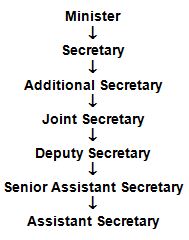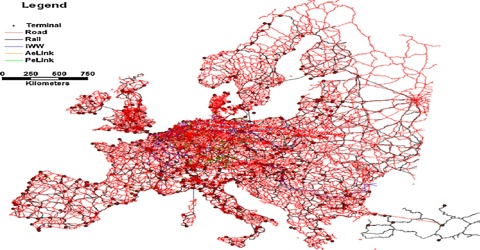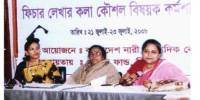Main purpose of this thesis is to analysis User of Zones for Gis-Based Transport and Socioeconomic Analysis in Bangladesh. Other objectives are to investigate zone concepts used for different purposes in Bangladesh and collect relevant transport and socio-economic information. Finally develop GIS maps to represent zone wise transport and socio-economic information.
Introduction
GIS is designed to accept geographic data from a variety of sources, including maps, satellite photographs, and printed text and statistics. The applications of a GIS are vast and continue to grow. By using a GIS, scientists can research changes in the environment; engineers can design road systems; electrical companies can manage their complex networks of power lines; governments can track the uses of land; and fire and police departments can plan emergency routes. GIS-based transport information of different zones in Bangladesh can make fulfillment of the entire data requirement in the form of maps and tables.
The study area needs to be defined to ensure that all data pertaining to present and future transportation needs are collected in an efficient and economic manner. These data may be in the form of maps, aerial photograph, charts or maps, and so on and may require the application of a large variety of engineering, environmental, social, and economic knowledge. By analyzing the collected data, study is subdivided by small units which ideally contain a homogeneous activity and closely related to types and intensity of land use. These small units are called zones.
Transportation is very important in every phase of our daily activities that it almost impossible to imagine what would be like without transportation. It is the movement of people and goods and the facilities used for that purpose. The movement of people assumes first importance in the minds of many, especially in urban areas, but the movement of goods, that is, freight transportation, is probably of greater significance to the functioning of our economic society. Both must be considered essential.
Transportation has been an essential part of most societies of the past. One can hardly conceive of a future society in which it would not continue to be essential. The adequacy of its transportation system is a fair index of a country’s economic development. An adequate and efficient transportation system is prerequisite for an overall development of a country. Transport acts as catalyst for socio-economic development which in turn generates demand for transport. Transportation systems, however the term is applied, are also subsystems in the socio-economic system.
Transportation, for example, is only one of several subsystems, albeit an important one, along with sewage, lighting water supply and other components of the socio-economic land use organization known as the urban system or community.
Bangladesh is a low lying country. Large number of rivers and canals crisscrossed the country all over causing construction of large number of bridges and culverts. The soil of Bangladesh is silty alluvium which has low CBR value. So, flood is a major problem here. Also cyclone creates same major problem. That is why infrastructures are highly affected with these occasional natural calamities. Due to natural calamities we get only 5-6 months alright for construction. Rest of the period is non-working. Also scarcity of good construction materials and inadequate fund is major problem in high way.
Due to siltation and corrosion, canal depth is being reduced, so frequent dredging is necessary. Riverbank is shifted due to corrosion and hence the relocation of part becomes very difficult. Also poor condition of river courses, bad storage facilities major ports, no specific training for drivers, manual time consuming loading unloading of goods in waterways transports are the common problem in Bangladesh.
Existence of non-uniform rail gauges, hinders smooth journey, absence of fixed crossing over rivers, inefficient management, lack of skilled manpower are the major problem in the rail ways of Bangladesh.
As small country, we can’t afford much air transit. Poor fare evaluation and travel agents control overall reservation causing major losses in revenue are the problem in air ways.
By studying all the problems of various modes of transport with respect to Bangladesh it can be said that analysis of collected socio-economic data and transport information system is must. Also the data analysis is required to get efficient, economic, dependable, serviceable, convenient and safe transportation facilities.
OBJECTIVES OF THE STUDY:
For the purpose of getting successful outcome from any research work, there should be certain goals and objectives. In research or studies, objectives must be set before. Objectives of the study help in determining the success of that particular study. The objectives formulated for this study are as follows:
- To investigate zone concepts used for different purposes in Bangladesh.
- To collect relevant transport and socio-economic information.
- To develop GIS maps to represent zone wise transport & socio-economic information.
ZONE IDENTIFICATION
WHAT IS ZONE:
The area for data collection needs to be defined. The area is subdivided into small geographic units called traffic analysis zones. The zone should ideally contain a homogeneous activity which is closely related to types and intensity of land uses. The zones should be small enough so that there are a large number of inter-zonal trips being made in the study area. Generally the study area is circumscribed by a boundary line known as cordon line.
The boundaries of these zones should, whenever feasible, coincide with census and with jurisdictional boundaries. The zones should also be small enough so that there are a large number of inter-zonal trips being made in the study area.
ZONES USED FOR DIFFERENT PURPOSES:
Zoning is performed in different perspectives. Those are as follows:
- Administrative zone
- Traffic zone
- Statistical zone
- Electoral zone
Administrative zone:
According to this type of zone, the study area is divided into Thana, Upazila, District, Division etc whereas the study area is a country like Bangladesh. In Dhaka city “ward” is also considered as a zone.
General administration:
There are two streams of the administrative structure of Bangladesh: I) Policy making centre or Secretariat and II) Field administrative.
I) The Secretariat:
The Secretariat is the source of administrative activities of Bangladesh Government and the centre of Government activities. The different ministries and the offices of their divisions are collectively called the Secretariat. In the Secretariat all the fundamental rules of administration are formulated and finally approved.
The Secretariat is divided into some Ministries. Every ministry is placed under a minister. But the administrative head of the ministry is the secretary. All the responsibilities of the ministry lie with the secretary. The chief function of the minister is formulation of projects and determination of policies. The secretary helps the minister in all affairs.
At the lowest level of the administrative structure of the secretariat in Bangladesh is the Assistant secretary and at the top is the Minister. It is shown in the following chart:

There may be more than one secretary, Additional Secretary, Joint Secretary, Deputy Secretary, Senior Assistant Secretary and Assistant Secretary in a Ministry. But the number of search officers depends on the importance and volume of activities in addition to ministry there are some Divisions, Departments and Directorate for proper functioning of Government activities and responsibilities. Among the Directorates there are Directorate of Education, Directorate of Health, Directorate of Fisheries etc. One Director General is in charge of one Directorate. The Directorates have been established for the implementation of various development programs. They work according to the principles formulated by the respective ministries.
II) Field Administration:
In Bangladesh, there is Unity form of Government. Areas of the country have been divided into different parts for the purpose of smooth and efficient administration. Here administration is run according to area or field administration is prevalent. In the administrative structure, the next stage of the centre is the Division. Every Division is divided into some districts and districts are divided into some Upazilas. The Upazilas are again divided into some unions and a union consists of some villages. In the administrative structure of Bangladesh local Government is prevalent under the central Government and local self-government. is prevalent at the union level.
(a) Divisional Administration:
There are Six Divisions in Bangladesh. The responsibility of the Divisional Administrative lies with the Divisional Commissioner. He is a senior member of the Bangladesh civil service (ADMINISTRATION). The Divisional commissioner supervises and coordinates the activities of the Deputy Commissioners. He gets all the facilities like a Joint Secretary. His activities are as follows:
- to manage the activities of the division relating to the revenue.
- to plan and implement public welfare activities.
- to do welfare works and take measure during natural calamities.
(b) District Administration:
Every division is divided into some districts. The Deputy Commissioner is the highest level officer of the district administration. He is a member of the Bangladesh civil service (Administration). A district is the heart of the administration of Bangladesh. There are at present, sixty-four districts in Bangladesh. A Deputy Commissioner has to perform following activities:
- to implement of all administrative decisions and principles taken in the secretariat.
- to supervise of the activities of different Govt. departments and providing help and co-operation to the government in the determination of principles.
- to fix and collect land revenue and other taxes as the chief collector by taking helps of the Additional Deputy Commissioner (Revenue).
- to maintain peace and tranquility in the district with the assistance of the Police Super as an administrator and a Judge.
- to performs various functions relating to development of agriculture, industry, education communication and population control f the district.
- to supervise and control the activities of various autonomous organizations and coordinates activities of all departments and organizations of the district.
(c) Upazila Administration:
Every district is divided into some Upazilas. There are 465 administrative Upazilas in Bangladesh which is proposed to be 476. The chief of the Upazila administration is the Upazila Nirbahi Officer (U.N.O.). He is also a member of Bangladesh civil service (administration). He works as the representative of the Deputy Commissioner in the Upazila.
He has to perform following activities:
- to supervise of all development and administrative activities, trying cases in the absence of magistrate, acting as the custodian of Treasury and Drawing and Disbursing Officer (D.D.O) of the Upazilas.
- to perform various activities delegated by the Government.
Administrative Structure of police:
The topmost officer of police administration in Bangladesh is the Inspector General of Police (IGP), who controls all departments of police under general supervision of the Home Minister. Senior police officials help him in his work at the Police Headquarters. A Deputy Inspector General of Police is appointed for each range or division (civil administrative unit) of the country. There are six police ranges and one railway police range. Police Commissioner of Dhaka Metropolitan Police, administrative heads of Criminal Investigation Department (CID) and Special Branch (SB) and the Director General of Rapid Action Battalion (RAB) are of the rank of Additional Inspector General.
The Superintendents of Police (SP) are the heads of police administration at the district level. An Additional SP, few Assistant Superintendents of Police and other officials help him in the discharge of his duties. An Assistant SP controls the police administration of a circle. An Officer-in-charge (OC) of the rank of an Inspector heads a Police station ( thana ) under a circle. There are now 573 Police station ( thana ) in the country including those in metropolitan police jurisdictions. After 1982, each thana was upgraded into a upazila (sub-district) and the existing unit of administration, i.e., ‘subdivision’ was abolished based on the recommendations of Committee for Administrative Reform/Reorganization (CARR) formed in early 1982 by the Ershad government. The principal functionary of an upazila was known as Upazila Nirbahi Officer (UNO). In 1992, the upazila system was abolished and the post of UNO was transformed into Thana Nirbahi Officer (TNO). Under the upazila system, the rank of the OC was upgraded into that of an inspector. The upazila system has since 1999 been revived.
Organizationally, Bangladesh Police has 10 branches and each branch has its own method of action. These branches are under the control of IGP, but they work almost independently. These branches are: District police administration, CID, Special Branch, Railway Police, Traffic Police, River Police, Metropolitan Police, Mounted Police, Armed Police Battalion, Range Reserve Force and Rapid Action Battalion.
Armed police from the Armed Police Battalion are kept reserved in districts and cities to face emergency law and order situations. Activities of CID and SB are extended up to the field level parallel to the mainstream police administration.
The Rapid Action Battalion is the latest addition to the police force, which has been constituted recently in accordance with an Act of Parliament. Forty four percent of this elite force comes from the police and the rest on deputation from various branches of the armed forces. It is at present headed by a Director General of the rank of Additional IG, while a Colonel from the Army is serving as the Deputy Director General. It has a number of battalions in the metropolitan cities of the country, but is mostly concentrated in capital Dhaka. It has gone into full-scale operation with effect from June 2004.
Traffic zone:
The so-called O-D database provides some indication of where the majority of trips are coming from and where they are going to and in which transportation corridors these trips are likely to travel. To determine the origins and corresponding destinations of the trips made in a study area is a critical step in the transportation planning process which is performed with zones and is designated as traffic zone.
Statistical zone:
The study area is divided into analysis zones in order to perform the statistical survey such as population census, people income source and other socio-economic data.
Electoral zone:
In order to perform the electoral system of the country, the study area is divided into some zones which are called electoral zone. Each zone may contain one or more than one upazila. Each zone belongs to a member of parliament (MP) of the Govt.
SOME KEY TRANSPORT RELATED INFORMATION
FUNCTION WISE CLASSIFICATION AND DEFINITION OF ROADS IN BANGLADESH:
Roads are classified functionally respect to Bangladesh as follows:
i) Rural Roads:
(a) National Highways
(b) Regional Highways
(c) Zila Roads
(d) Upazila Roads-A
(e) Upazila Roads-B
(f) Union Roads
(g) Village Roads
ii) Urban Roads:
- Primary / Main / Arterial Road
- Secondary Road / Collector Road
- Local Road / Access Road
Definition:
- National Highways: Highways connecting the national capital with divisional headquarters, old district headquarters, port cities and international highways.
- Regional Highways: Highways interconnecting district headquarters (HQ) of the region and with national highways.
- Zila Roads: Roads connecting upazila HQ with R&H road network.
- Upazila Roads-A: Roads connecting major rural market/ development centers (growth centers) with Upazila HQ and R&H network and also one upazila with other upazila.
- Upazila Roads-B: Roads connecting union headquarters and local markets with the upazila headquarter or the road system.
- Union Roads: Roads connecting village and farms to local markets and union headquarter.
- Village Roads: Roads within a village or between villages.
- Urban Roads: Roads within the territorial boundaries of cities/towns and under Municipal Corporation or pourashavas.
BANGLADESH GOVERNMENT MINISTRIES INVOLVED IN THE TRANSPORT SECTOR:
The Government Ministries which have responsibilities in the transport sector, and provides information on their roles and responsibilities are listed below in the table 3.1.
Table: Bangladesh Govt. ministries involved in the transport sector
| Ministry | Agency | Transport Sub-Sector | Mode | Role & Responsibility |
| Ministry of Finance | All | All | Financial allocations (ADP, Revenue, PSOs, etc) | |
| Ministry of Planning | Planning Commission | All | All | Policies, planning, appraisals, co-ordination, modal integration & monitoring. |
| Ministry of Communication | Roads & Highways Department (RHD) | Road Infrastructure | Road | Management of national roads & bridges (<1 km) (including construction, rehabilitation, maintenance, heavy vehicle management) & Ferry services |
| Bangladesh Bridge Authority (BBA) | Road Infrastructure | Road (Bridges) | Management of major bridges (>1 km) (including maintenance) | |
| Bangladesh Road Transport Association (BRTA) | Road Transport | Road | Regulation of road transport services (including veh. registrations, route permits. Fitness certificates, licenses, traffic signs, heavy vehicle mgt. (with RHD / LGED), road safety ) | |
| Bangladesh Road Transport Corporation (BRTC) | Road Transport | Road & Urban transport | Management & operation of public transport passenger services | |
| Bangladesh Railway (BR) | Rail | Rail | Management & operation of rail infrastructure, freight & passenger services | |
| Ministry | Agency | Transport Sub-Sector | Mode | Role & Responsibility |
| Ministry of Local Govt., Rural Development and Cooperatives (MLGRDC) | Local Govt. Engg. Dept. (LGED) | Road infrastructure | Road | Management of rural roads & bridges ( including construction, rehab., maintenance, heavy vehicle mgt. ) |
| City Corporations and Municipalities | Urban transport infrastructure | Urban transport | Management of urban roads ( incl. planning, construction, rehab., maintenance) and urban traffic mgt. ( incl. traffic signals) | |
| Ministry of Works (MOW) | City Development Authorities | Urban roads | Urban transport | Construction of urban roads > 60 ft wide (maintenance under City Corporations) |
| Ministry of Shipping (MOS) | Bangladesh Land Ports Authority (BSBK) | Road infrastructure | Road & Rail | Management & operation of land ports ( border trade) |
| Dept. of Shipping | Maritime Ports | Ports | Administration & regulation of maritime ports | |
| Chittagong Port Authority | Maritime Ports | Ports | Management & operation of Chittagong port, operation ( with BR) of Dhaka Inland Container Depot (ICD) | |
| Bangladesh Inland Waterway Transport Association (BIWTA) | IWT infrastructure | IWT | Management & operation of IWT infrastructure (incl. river ports, landing stations, cargo handling equipment(ports), navigation aids, dredging / route maintenance ) & tariff-setting | |
| Bangladesh Inland Waterway Transport Corporation (BIWTC) | IWT infrastructure | IWT | Management & operation of public sector vessels, dockyards & IWT and coastal / off-shore services (incl. passengers, dry cargo & tankers ), and ferry services | |
| Ministry | Agency | Transport Sub-Sector | Mode | Role & Responsibility |
| Ministry of Civil Aviation And Tourism (MOCA) | Civil Aviation Authority of Bangladesh (CAAB) | Civil Aviation | Civil Aviation | Management of civil aviation (incl. airports, runways, taxiways, terminal buildings, ATC, ANS, buildings, etc) |
| Biman, Bangladesh Airlines | Air transport services | Civil Aviation | Air transport passenger services (international & domestic), international air cargo services | |
| Ministry of Home Affairs (MOH) | Dept. of Police (Taffic) | Road & Urban transport | Road & Urban transport | Enforcement of road transport laws and regulations, traffic accident data collection |
In addition to the organizations listed in above table, there are other agencies under Local Government (MLGRDC) and other different ministries that influence functioning of the transport sector, as follows:
→Ministry of Local Government, Rural Development and Cooperatives (MLGRDC) – Water and Sewerage Authority
→Ministry of Water Resources (MWR) – Bangladesh Water Development Board (BWDB);
→Ministry of Telephone and Telegraph (MTT) – Bangladesh Telephone and Telegraph Board (BTTB); and
→Ministry of Energy and Mineral Resources (MEMR) – Gas distribution companies – Bangladesh Power Development Board
-Rural Electrification Board (REB)
BWDB,s responsibilities include dredging rivers and constructing flood embankments on which roads are often constructed. The other agencies, particularly WASA, BTTB and gas distribution companies negatively impact efficiency and maintenance of roads, particularly in urban areas.
SOURCE: ROAD MASTER PLAN: STATUS REPORT (August, 2005), PLANNIN COMMISSION.
INTEGRATED MULTI-MODAL TRANSPORT SYSTEM OF BANGLADESH:
A major development in long-distance freight transportation since the 1950s has been the use of multimodal transportation carriers. Multimodal transportation is the combination of two or more transportation modes used to move freight from origin to destination. Multimodal transportation improves the transfer of freight from intercity movement to local distribution. An example of this is the combined use of trucks and trains to move cargo over longer distances. Truck trailers are loaded with goods, driven to a rail yard, and transferred to a rail flatcar. They are then moved a long distance by train, unloaded at the destination rail yard, and driven to a market or a supply warehouse. Such a freight trip is called trailer-on-flatcar or container-on-flatcar. Multimodal transportation requires cooperation and agreements relating to prices and delivery arrangements among the different carriers.
Multimodal freight transport represents an integrated system for moving goods quickly and inexpensively from shipper to consignee by at least two different modes under a single contract. Multimodal transport has typically targeted mainly developed economies comprising highly integrated supply chain systems in which modelling and optimisation of some system component is required ahead of further development. The role of an efficient transport system in providing a catalyst for national economic growth is well-rehearsed as transport and logistics service quality influence both the demand for products and services and delivery cost and time. Pressures to raise the productivity and efficiency of freight transport also increase as manufacturing and service sectors adopt logistical concepts including just-in-time and supply chain integration accompanied by globalisation and electronic data interchange. To develop a normative model for efficient goods movement promoting supply chain integration in developing countries, the influence of containerisation and some benefits and limitations of multimodalism should be considered. After reviewing the trend towards supply chain integration, the roles of intermediaries and shippers or manufacturers are considered. Barriers to supply chain integration in developing economies of Bangladesh, and its particular transport problems which affect the scope for multimodal transport should be considered. Multimodal freight transport is then considered as a catalyst for removing trade barriers, providing a model for achieving supply chain integration.
Bangladesh faces barriers to international trade which also impede supply chain integration. Impediments to the smooth flow of cargo include transport, customs, business practices, knowledge and skill on logistics management, information technology, banking and insurance.Despite a liberal economic policy in recent decades, many port, terminal and rail services are offered by government bodies incurring financial losses.Growing exports and imports shifted trade towards manufactured and finished goods rapidly increasing movements of containers through Chittagong Port to and from Dhaka, the main load centre. Although containerised cargo volumes between these two points are theoretically sufficient to support multimodal services, investment in port and inland terminals handling equipment and facilities has not kept pace. The international competitiveness of Mongla port is reduced by high ship turnaround times in port which increase transport costs, transit times and unreliability. Limited inland transport infrastructure by road, rail and waterway serving both ports has developed to accommodate door-to-door movement of containers. Ship delays in Chittagong are directly related to insufficient and inadequate port facilities and a fragmented inland transport system.Corruption in the form of toll collection on the inland leg of international transport may exacerbate delays. Seaports inaccessible to door-to-door containerised cargo movement present the greatest barrier to an efficient and integrated transport system.
Too few logistics centres or ICDs have been developed close to load centres, restricting freight forwarders’ ability to offer door-to-door pick-up and delivery services. With little regulation to govern freight forwarder operations, few are equipped with information systems reporting freight rates and transit times. Shippers or consignees are unable to find information about consignments because of inadequate modern communication technology, particularly EDI. Many shippers lack knowledge of EDI or its potential benefits. With only 6 or 7 h transit time separating major cargo centres, road transport has the potential to contribute to an integrated and efficient door-to-door service by performing the inland leg of international multimodal transport. Bangladesh has regularly spent about 15% of its development budget on surface transport, yet users cannot access door-to-door services. The Dhaka–Chittagong road corridor is adequate for container movements, but feeder roads are not, denying locations set away from the main corridor any multimodal transport by road. Owing to scarcity of wagons, locomotives, handling equipment, insecurity of cargo, infrequent services, non-availability of containers and suspicion of a commercial attitude, main line operators do not encourage door-to-door movement of containers by rail. Inland shipping is considered a low-cost mode, which like road, suffers insufficient inland container-handling facilities and container terminals. The inland transport infrastructure hampers both trade and investment.
There are few origin-to-destination transport and logistics services, denying integrated, efficient, reliable door-to-door transport, raising logistics costs and adversely affecting the competitiveness of products in the global market. Change towards efficient containerisation and multimodal transport is hampered by delays and confusion arising from multiple ministries involved in administering transport services and multimodal development.
Bangladesh’s trade with neighbouring countries is increasing, particularly with India, but is asymmetric, dominated by movements from India along formal and informal channels, widening the trade deficit. Exports from Bangladesh to neighbouring countries involve a narrow product range, hampered by limited liberalisation and higher tariff and non-tariff barriers in India.Until Bangladesh diversifies and expands its export base, trade imbalances will exacerbate empty running causing higher costs and unreliable services. Such inefficiencies translate into higher commodity costs and reduce the trading credibility and status of the countries in the regional and international market. A regional strategy would ensure effective and efficient transport corridors .
The success of transport corridors is constrained by documentation and procedural inefficiencies. Protocols restrict cross-border movement of trucks and route choice. Gaps in physical infrastructure include incompatible physical transport links or facilities at border crossings including warehouses, parking and storage and terminal facilities. Natural barriers comprise hundreds of rivers, with about 80 river gaps, lacking bridges on the road network requiring ferries.These rivers restrict road and rail transport in the rainy season through flooding, even where there are bridges. Unlike road, rail does not require transhipment at border crossings, but has not attracted substantial traffic. Five rail routes operate between India and Bangladesh, with both governments owning rail-operating organisations. It is not known whether scale economies could be achieved by closing routes which generate inadequate social or commercial returns. Rail could capture some medium-value cargo but requires an integrated network. Inland waterway incurs longer transit times and little cargo is available. As road hauliers do not have the right to carry cargo on the roads of neighbouring countries, they require transhipment at border crossing. With a dozen border crossings, road will dominate in the transport of higher-value goods between Bangladesh and India. Potentially, road could offer combined transport, with short haul collection and delivery services for rail or waterways on longer hauls. This needs ‘prioritised cooperation to develop an integrated transport system and infrastructure through collective action with equipped logistics centres or inland terminals. Increased cooperation with neighbouring countries may also improve relations between private parties engaged in trade.
An idealised multimodal transport system should be developed for an integrated supply chain in which all shippers and consignees have access to door-to-door services from factory premises to port or through inland clearance depots. Full integration into the international supply chain is only possible when all shippers and consignees have been empowered to access multimodal door-to-door services. To promote multimodal freight transport demands cooperation between parties is required. Governments must encourage investment and training in relevant modern information technology. They must retain responsibility for identifying and promoting potential load centres given that multimodal transport poses significant risks in investments favouring large load centres with long containerised goods hauls offering scope for low unit costs per load, with high terminal handling and other fixed costs. The potential for developing multimodal systems is limited in countries like Bangladesh by short hauls and domestic markets with limited total purchasing power, but increases where transport services are efficient with no intermediate handling.
GIS REPRESENTATION OF TRANSPORT AND SOCIO-ECONOMIC DATA
ROAD NETWORK CHARACTERISTICS OF DIFFERENT AGENCIES:
Roads & Highways Dept. (RHD):
Roads & Highways Dept. (RHD) is responsible for management of road network system in Bangladesh. So far RHD’s road network system consists of more than 21,560 km of roads in three categories namely National Highways, Regional Highways and Zila Roads. RHD has divided the whole Bangladesh into seven zones which are Dhaka, Chittagong, Khulna, Rajshahi, Barisal, Comilla & Rangpur.
RHD road network covers over 21,560 km of roads and there exist approximately 14,679 bridges and culverts of span of more than 3.0 meter on these roads. That means there is one structure per 1.40 km of road and 12.47 m of bridging per km of road. RHD road network can be seen in table 4.1.
Table: RHD road network
| Type of road | No. of roads | Total Length (km) |
| National Highway | 66 | 3520.50 |
| Regional Highway | 113 | 4286.81 |
| Zila Road | 617 | 13752.73 |
| Total | 796 | 21560.44 |
Road length of each RHD zones can be seen in table4.2.
Table: Details of zone wise road length
| Zone | Road type | Road Lengths (km) | Paved Road Lengths (km) | Unpaved Road Lengths (km) |
| Barisal | National | 395.867 | 274.469 | 0.000 |
| Regional | 421.140 | 373.975 | 0.000 | |
| Zila | 1777.311 | 415.408 | 33.650 | |
| Total | 2594.318 | 1063.852 | 33.650 | |
| Chittagong | National | 391.133 | 386.532 | 6.998 |
| Regional | 437.552 | 276.721 | 22.976 | |
| Zila | 1717.325 | 260.880 | 118.673 | |
| Total | 2546.010 | 924.133 | 148.647 | |
| Dhaka | National | 718.099 | 609.880 | 5.157 |
| Regional | 1195.904 | 925.478 | 12.925 | |
| Zilla | 2350.206 | 1142.311 | 75.223 | |
| Zone | Road type | Road Lengths (km) | Paved Road Lengths (km) | Unpaved Road Lengths (km) |
| Total | 4264.209 | 2677.669 | 93.305 | |
| Khulna | National | 371.280 | 351.757 | 0.000 |
| Regional | 608.100 | 549.549 | 0.000 | |
| Zila | 1684.766 | 725.545 | 92.420 | |
| Total | 2664.146 | 1626.851 | 92.420 | |
| Rajshahi | National | 370.628 | 327.516 | 0.000 |
| Regional | 461.757 | 439.816 | 0.039 | |
| Zilla | 1358.947 | 472.998 | 88.657 | |
| Total | 2191.332 | 1240.330 | 88.696 | |
| Comilla | National | 656.754 | 552.144 | 0.000 |
| Regional | 737.687 | 525.490 | 9.446 | |
| Zila | 2310.526 | 985.283 | 50.773 | |
| Total | 3704.967 | 2062.917 | 60.219 | |
| Rangpur | National | 604.706 | 577.346 | 0.000 |
| Regional | 311.400 | 278.380 | 5.474 | |
| Zila | 1864.336 | 510.472 | 32.138 | |
| Total | 2780.442 | 1366.198 | 37.612 |
Source: Road network database of Bangladesh (Annual Report 2004), Roads & Highways Dept. (RHD), Bangladesh.
Bangladesh Railway:
Bangladesh Railway has a total of 2,855 route kilometers at the end of the year 2004-2005. Bangladesh Railway has divided the whole country into two zones namely East and West. East zone has 1,277 route kilometers of MG track only and West zone has 553 route kilometers of MG 660 route kilometers of BG and 365 route kilometers of DG track. The total length of running track including track on double line, in the yards and siding is 4,443 kilometers.
At the end of 2004-2005, there were a total of 3,650 bridges of which 3,104 are minor and 546 are major ones. Foot over-bridges are provided in important cities and district towns. At the end of 2004-2005, Bangladesh Railway has a total of 454 stations of which 239 MG stations in the East zone and 134 BG & 81 MG stations in the West zone. At the end of 2004-2005, Bangladesh Railway has a total of 1,610 level crossings of which 207 level crossings having heavy road and rail traffic are manned round the clock and 1,188 with light traffic are casually manned. At the end of 2004-2005, only 44 districts of the country could be connected by Railway. The district wise Railway stations and Route kilometers are shown in table 4.4
Table: District Wise Railway Stations and Route Kilometers
| Sl No. | District | No. of Stations | Kilometers |
| 1 | BAGERHAT | 0 | 42.95 |
| 2 | KHULNA | 7 | 28.24 |
| 3 | JESSORE | 11 | 57.42 |
| 4 | JHENAIDAH | 5 | 43.40 |
| 5 | CHUADANGA | 9 | 44.25 |
| 6 | FARIDPUR | 0 | 43.80 |
| 7 | GOPALGANJ | 0 | 34.13 |
| 8 | RAJBARI | 9 | 94.22 |
| 9 | KUSHTIA | 10 | 59.35 |
| 10 | SERAJGANJ | 9 | 48.0 |
| 11 | PABNA | 10 | 61.0 |
| 12 | CHAPAINAWABGANJ | 6 | 69.81 |
| 13 | RAJSHAHI | 13 | 63.0 |
| 14 | NATORE | 8 | 37.0 |
| 15 | NAOGAON | 5 | 29.0 |
| 16 | JOYPURHAT | 4 | 54 |
| 17 | THAKURGAON | 7 | 50 |
| 18 | PANCHAGARH | 3 | 22.0 |
| 19 | NILPHAMARI | 9 | 66.68 |
| 20 | KURIGRAM | 9 | 51.0 |
| 21 | DINAJPUR | 18 | 152 |
| 22 | LALMONIRHAT | 15 | 110 |
| 23 | RANGPUR | 9 | 69 |
| 24 | GAIBANDHA | 16 | 80 |
| 25 | BOGRA | 18 | 84 |
| Sl No. | District | No. of Stations | Kilometers |
| 26 | TANGAIL | 5 | 68 |
| 27 | JAMALPUR | 18 | 102.90 |
| 28 | NETROKONA | 13 | 65 |
| 29 | KISHOREGANJ | 11 | 73.75 |
| 30 | MYMENSINGH | 23 | 128.33 |
| 31 | GAZIPUR | 11 | 91.80 |
| 32 | DHAKA | 7 | 30 |
| 33 | NARAYANGANJ | 2 | 9.5 |
| 34 | NARSINGHDI | 12 | 38.97 |
| 35 | SUNAMGANJ | 3 | 13.9 |
| 36 | BRAHMANBARIA | 11 | 72.19 |
| 37 | HABIGANJ | 25 | 85.87 |
| 38 | MOULVI BAZAR | 14 | 125.33 |
| 39 | SYLHET | 8 | 50.64 |
| 40 | NOAKHALI | 8 | 29.4 |
| 41 | CHANDPUR | 11 | 40.66 |
| 42 | COMILLA | 16 | 106.4 |
| 43 | FENI | 5 | 51.73 |
| 44 | CHITTAGONG | 45 | 178.45 |
Source: Railway Information Book 2005, Bangladesh Railway.
City Corporation:
There are six city corporations in Bangladesh which perform the management activities of the road network in the six divisions namely Dhaka, Chittagong, Khulna, Rajshahi, Barisal and Sylhet. City Corporation performs all sorts of activities including planning, road construction, maintenance, traffic control & management etc.
SOCIO-ECONOMIC DATA
ROAD NETWORK CHARACTERISTICS OF DIFFERENT AGENCIES:
Roads & Highways Dept. (RHD):
Roads & Highways Dept. (RHD) is responsible for management of road network system in Bangladesh. So far RHD’s road network system consists of more than 21,560 km of roads in three categories namely National Highways, Regional Highways and Zila Roads. RHD has divided the whole Bangladesh into seven zones which are Dhaka, Chittagong, Khulna, Rajshahi, Barisal, Comilla & Rangpur.
RHD road network covers over 21,560 km of roads and there exist approximately 14,679 bridges and culverts of span of more than 3.0 meter on these roads. That means there is one structure per 1.40 km of road and 12.47 m of bridging per km of road. RHD road network can be seen in table
Table : RHD road network
| Type of road | No. of roads | Total Length (km) |
| National Highway | 66 | 3520.50 |
| Regional Highway | 113 | 4286.81 |
| Zila Road | 617 | 13752.73 |
| Total | 796 | 21560.44 |
Road length of each RHD zones can be seen in table4.2.
Table: Details of zone wise road length
| Zone | Road type | Road Lengths (km) | Paved Road Lengths (km) | Unpaved Road Lengths (km) |
| Barisal | National | 395.867 | 274.469 | 0.000 |
| Regional | 421.140 | 373.975 | 0.000 | |
| Zila | 1777.311 | 415.408 | 33.650 | |
| Total | 2594.318 | 1063.852 | 33.650 | |
| Chittagong | National | 391.133 | 386.532 | 6.998 |
| Regional | 437.552 | 276.721 | 22.976 | |
| Zila | 1717.325 | 260.880 | 118.673 | |
| Total | 2546.010 | 924.133 | 148.647 | |
| Dhaka | National | 718.099 | 609.880 | 5.157 |
| Regional | 1195.904 | 925.478 | 12.925 | |
| Zilla | 2350.206 | 1142.311 | 75.223 | |
| Zone | Road type | Road Lengths (km) | Paved Road Lengths (km) | Unpaved Road Lengths (km) |
| Total | 4264.209 | 2677.669 | 93.305 | |
| Khulna | National | 371.280 | 351.757 | 0.000 |
| Regional | 608.100 | 549.549 | 0.000 | |
| Zila | 1684.766 | 725.545 | 92.420 | |
| Total | 2664.146 | 1626.851 | 92.420 | |
| Rajshahi | National | 370.628 | 327.516 | 0.000 |
| Regional | 461.757 | 439.816 | 0.039 | |
| Zilla | 1358.947 | 472.998 | 88.657 | |
| Total | 2191.332 | 1240.330 | 88.696 | |
| Comilla | National | 656.754 | 552.144 | 0.000 |
| Regional | 737.687 | 525.490 | 9.446 | |
| Zila | 2310.526 | 985.283 | 50.773 | |
| Total | 3704.967 | 2062.917 | 60.219 | |
| Rangpur | National | 604.706 | 577.346 | 0.000 |
| Regional | 311.400 | 278.380 | 5.474 | |
| Zila | 1864.336 | 510.472 | 32.138 | |
| Total | 2780.442 | 1366.198 | 37.612 |
Source: Road network database of Bangladesh (Annual Report 2004), Roads & Highways Dept. (RHD), Bangladesh.
CONCLUSIONS:
Zone wise (District) transport and socio-economic data is collected and represented in GIS maps.
RECOMMENDATIONS FOR FUTURE IMPROVEMENT:
- To make more precise GIS based analysis of study area, zoning area should be taken small as possible depending on the availability of data.
- Since the lacking of geo-referencing (providing latitude and longitude) in GIS map of CEGIS and RHD or LGED, there are the difficulties to make an overlay between them. That is why, the map of RHD has been digitized for the zones of administration to make overlays of river, road network and socio-economic data based map. Hence, geo-referencing should be performed.
- There is a limitation in getting comprehensive data of transport information and socio-economic in the level of small zoning area. But, if the data of small zoning area is available, then it is easer to integrate the data to get large zoning area which makes GIS based representation more fruitful.
















